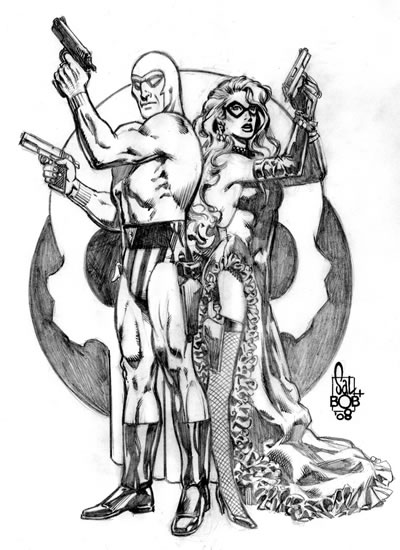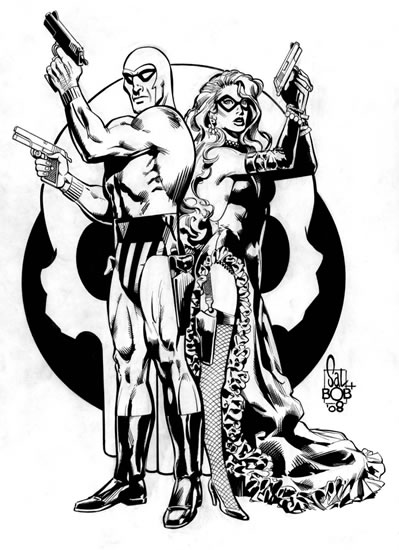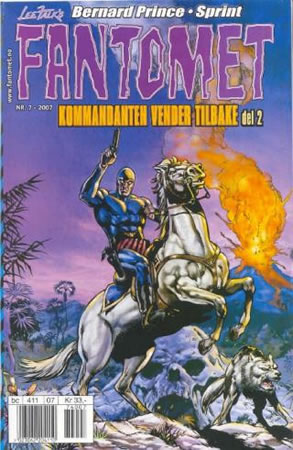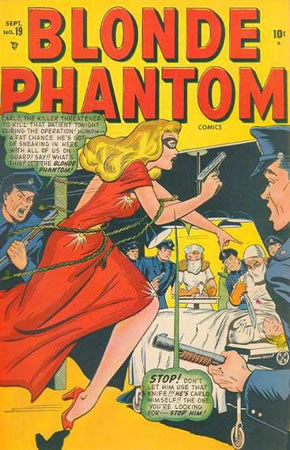Ghosts who walk
I promised you a Sal Velluto and Bob Almond "Common Elements" commission two-fer. Doesn't your Uncle Swan always deliver?
Recently, the redoubtable Mr. Velluto has been creating cover art for Egmont, a Swedish company that publishes new comic book adventures of Lee Falk's ageless jungle hero, the Phantom. (Sal may be doing some of the interior art also, but it's difficult to tell from Egmont's Web site — given that I don't read Swedish.)
Hearing that news, I decided to invite Sal & Bob (best known for their three-year collaboration on another African-based series, Black Panther) to pair the Ghost Who Walks — as the Phantom is frequently called — with another classic hero, the beautiful but deadly Blonde Phantom. Below is Sal's finished pencil art...

...complemented by the inks of Bob Almond.

The Phantom holds a historic distinction as perhaps the first fictional character who combined all of the elements we associate today with the term "superhero."
The Phantom wasn't the first hero to wear tights (Robin Hood may have that honor), or have a masked secret identity (that's probably Baroness Orczy's Scarlet Pimpernel), or operate from a secret base (Doc Savage's 86th Floor, Hidalgo Trading Company, and Fortress of Solitude predate the Phantom by a couple of years), or demonstrate superhuman abilities (we can go back at least as far as the Biblical Samson for that). Falk's lavender-clad jungle warrior was, however, probably the first to bring all of those characteristics together, and certainly the first in the comics medium. The Phantom made his debut in 1936, beating Superman — who's usually thought of as the "original" comic superhero — to the newsstands by a good two years.
In reality, the Phantom is Christopher "Kit" Walker, the 20th successive descendant of the original Phantom to wear his trademark costume. (The fact that a score of different men over a period of several hundred years have donned the Phantom's mask makes the hero appear immortal — hence, "The Ghost Who Walks.") From the Skull Cave, his hidden lair deep in the African jungle (it was on the Indian subcontinent in Falk's earliest stories, but later retconned), the Phantom battles evil in all its forms, blazing away with his twin .45 pistols and leaving the brand of his famed skull ring on the foreheads of his vanquished foes.

Although the Phantom has existed in newspapers since the '30s — his strip continues to be published by King Features Syndicate, with Tony DePaul writing the stories and the great Paul Ryan drawing the pictures — he has frequently ventured into comic books as well. The Phantom's earliest stapled incarnations consisted of reprinted strips, but almost all of the major comics publishers (and several not-so-major ones) have held the franchise to publish new Phantom stories at one time or another. In the U.S., the Phantom's monthly comic stories are currently published by Moonstone; Egmont publishes the completely distinct Scandinavian version, and Frew the Australian counterpart.
Correcting a common Phantom misconception: Although Lee Falk created the Phantom and his name is the one most associated with the hero, Falk only wrote the Phantom's adventures, giving up the art chores after the first few strips. More than a dozen artists have worked on the series over the decades, including Ray Moore, Wilson McCoy, Carmine Infantino, George Olesen, and the legendary Sy Barry, who retired in 1994 after 33 years.
As for the Blonde Phantom, she's something of a pioneer herself.

The Blonde Phantom — in everyday life, secretary Louise Grant — was one of the "second wave" of superheroines introduced in the post-World War II era, as the mostly male heroes of the war years began to decline in popularity. Based on the physical attributes of such wartime pinup queens as Betty Grable (whom the Blonde Phantom resembles), these heroines — including Phantom Lady, the Black Canary, Venus, and Sun Girl, — were designed to appeal both to the returning servicemen and to female readers.
Most of these characters, sadly, were short-lived, though interest in many of them (especially Black Canary and Phantom Lady) has picked up in recent years. The Blonde Phantom remains largely forgotten. But you have to love a woman who could fight crime wearing a floor-length, slit-skirted red dress and high heels.
And that's your Comic Art Friday.
Labels: Comic Art Friday









4 insisted on sticking two cents in:
There was a brief Blonde Phantom revival a few years ago. Louise Mason ended up as a supporting character in She-Hulk during the book's run by John Byrne. That was the breaking the fourth wall with a sledgehammer period, so the reason Louise wanted to become a supporting character was that characters that regularly appeared in comics didn't age, while characters in limbo did. So she appeared as a 50ish type, but figured being in She-Hulk would stop her from aging further.
Her daughter became Blonde Phantom II for a few issues, but I don't believe has appeared anywhere else; nor has the original since her She-Hulk appearances.
In a perfect world we'd get to see the Black Panther and the Phantom cross paths in Africa. I would've loved to have seen the Phantom at T'Challa and Ororo's wedding. Guess the only way we'll the African Avenger and the Ghost Who Walks together is by commission.
Tom: Thanks very much for the Blonde Phantom update. I've never read She-Hulk's solo book, so I wasn't aware of Louise's revival. I can always count on you to fill in the background!
Damon: Funny you should mention that. I'm planning a future T'Challa-meets-Kit Walker Common Elements commission even as we speak.
Post a Comment
<< Home